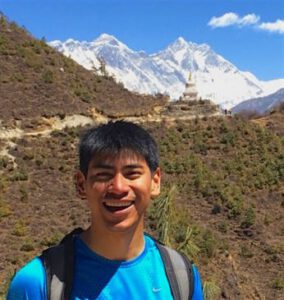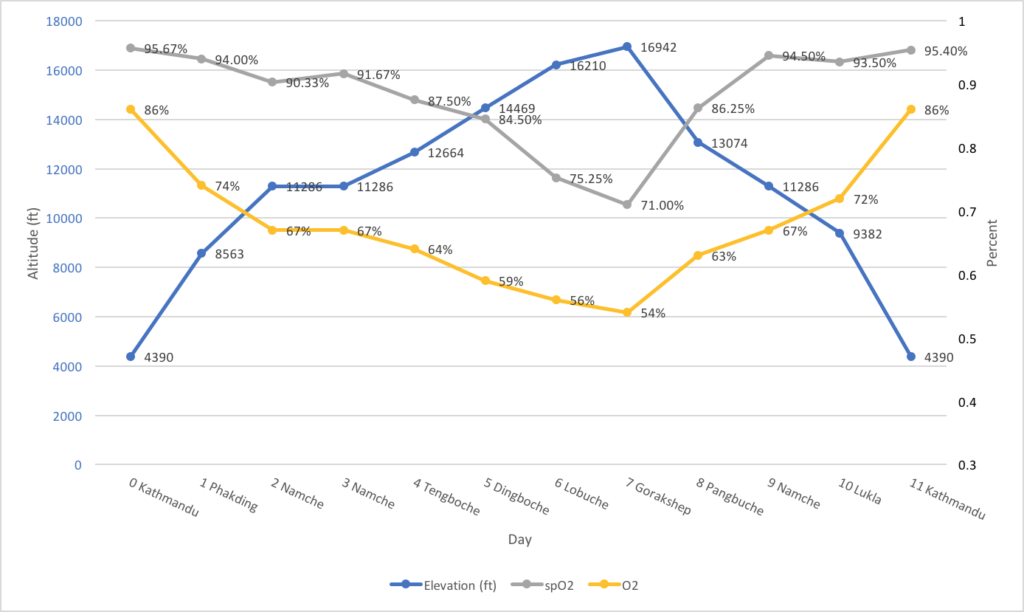
Fah getting ready for his trek to Everest base camp. Everest can be seen in the background.
On vacation trekking the Himalayas with his partner, 23andMe computational biologist Fah Sathirapongsasuti didn’t just take snapshots of surrounding peaks, he also did a little science at 17,000 feet.
As he hoofed along the trail to Everest base camp, Fah recorded the toll of hiking at altitude took on his body, monitoring his heart rate, the oxygen saturation in his blood, the number of calories he burned, and his disrupted sleep patterns.
“There were a few days that I felt pretty miserable,” he said.
Collecting data on vacation might not be on the top of your trip itinerary, but Fah saw an opportunity. He saw a chance to record in real time and with real data, the impact of altitude on the human body. And, he thought if enough people like him recorded their data and pooled it together, perhaps he could learn something more about why some of us do better than others at higher elevations. (You can see morea about how he tracked his data here, or look at the sidebar to learn more about how you could track your own data if you’re planning a trip to higher elevations.)
“I don’t think you need to be a geek or a scientist to enjoy collecting data during your vacation,” said Fah. “Our ability to adapt to foreign environments such as high altitude is a testament to the wonder of the human body. Quantifying it will help you see and appreciate your own body more.”
Fah’s DIY Altitude Science Field Guide
I don’t think you need to be a geek or a scientist to enjoy collecting data during your vacation. Our ability to adapt to foreign environments such as high altitude is a testament to the wonder of the human body. Quantifying it will help you see and appreciate your body more. Plus, monitoring your blood oxygen level (SpO2) during high altitude trekking can literally save your life!
My data from Everest Base Camp Trekking can be found here. If you are planning a trip up the mountains, to elevations higher than 9,000 feet, I’ve outlined how you too can track this data.
What to track?
If you are traveling to a “very high altitude” — defined as anything higher than 11,500 ft (e.g. Mt Whitney, Machu Picchu, or Mount Kilimanjaro) — there are a few experiments you can try.
I found that the oxygen saturation in my blood, now easily measured using a pulse oximeter that can be clipped to your finger and also tracks your pulse rate.
The key here is to record at three consistent times each day:
- On arrival at your resting point (e.g. campsite or , lodge)
- Before bed
- Morning, within the first hour after waking up
When recording the data, you should also make note of the elevation, and whether you have any symptoms of altitude sickness. For me, that amounted to nausea, dizziness, restless sleep and blurred vision. Beyond those three key points of measuring your blood oxygen, you should also measure immediately after exertion, that could include hiking or climbing or skiing. Whatever you are doing at elevation that is physically taxing. Record the exercise. Measure your heart rate and SpO2 immediate after exercise. Keep repeatedly measuring every 30 seconds after you’ve finished the “exercise” until your heart rate returns to normal. For me, this was instructive because I was able to see that I could recover even from the most strenuous exertions relatively quickly with a relatively If you are going to a moderately high altitude location (4,900-11,500 ft), such as Aspen or Lake Tahoe, it is less likely that you will experience altitude sickness., But you may observe changes in your physiology especially during an exercise. You might consider doing some strenuous exercise such as a sprint and measure your SpO2. You might be surprised by how low it can get.
What You’ll Need
Like any good experiment you’ll need a few things to ensure you can record good data. You’lld need a good pulse oximeter. There are several brands. The one I used is iHealth Air Pulse Oximeter available on Amazon. In addition you’ll need a fitness tracker. There are several acceptable, each with its own features and quirks. I use Fitbit Charge HR, mostly for the balance between price and features. Make sure it has continuous heart rate monitor and accelerometer (for steps and elevation gain estimate).
Although we can acclimatize to exertion at elevation, some people adapt to life at higher altitudes better than others. Sherpas, the ethnic group that has lived for thousands of years in the Himalayas, have a genetic advantage for life in the thin oxygen air of their homelands. So do Tibetans. Their genetic advantage is something they inherited from our ancient human cousins, the Denisovians, more than 40,000 years ago. Variants in two genes EPAS1 and EGLN1 are prevalent in Tibetans. Among everyone else, it’s hard to predict who will be get sick at high elevations and who won’t.
Most people know that climbing Everest is fraught with peril, but fewer know that just trekking to base camp can pose a danger due to altitude sickness. Although there aren’t accurate statistics on the number of trekkers hit by altitude sickness on the trail, a few die each year from what’s called Acute Mountain Sickness or underlying conditions that are exacerbated by exertion at altitude. But currently there is no good way to determine who might get sick and who won’t.
Fah and his partner were careful and prepared for their trek. Both of them are in shape, but even so they had days that were very difficult. Fah thought this was likely so he wanted to record the data to see how his body changed during the hike, and to see how it affected him differently than others.
“I know what I felt, but I wanted to see the data too,” he said.
There were some obvious data points. The higher Fah went, the lower the oxygen saturation in his blood.
“Duh,” he joked.
Although it wasn’t surprising, the data dramatically illustrated the impact of altitude. As Fah crossed the pass between Lobuche and Gorakshep at more than 16,000 feet, his oxygen saturation dropped below 80 percent, and his resting heart rate spiked upward. He got headaches, felt dizzy and his vision blurred. Fah slept less. None of that is atypical. In fact having your oxygen saturation drop below 80 percent for an extended period is very dangerous.
Over the week long trip, Fah slowly acclimatized to the higher elevations. And his numbers got better, but in general, there was a direct correlation between how bad he felt and elevation gain. Beyond what he felt and what he was recording, Fah also knew that there are many studies on this.
Out of curiosity Fah also added one other data point, he measured the oxygen saturation of three of the Sherpas helping to ferry some of the supplies for the trekkers. On average their oxygen levels were three to five percentage points higher than Fah, and they were much more comfortable.
As Andrew Murry, a physiologist at the University of Cambridge in the UK recently told NPR:
“You don’t need to spend very long in that part of the world to see that the people living there, particularly the Sherpas, perform extremely well at altitude — a lot better than we do.”
Over time many of us can acclimate ourselves to exertions at higher altitudes, improving our blood oxygen saturation levels, for instance. And Fah was able to see how, even in the short time he was in Nepal, his body acclimated itself to the higher elevations.

Oxygen saturation (SpO2, gray line) decreased as the elevation (blue line) increased. Symptoms of altitude sickness such as headaches, blurry vision, and sleeplessness are common when SpO2 dropped below 80, between Day 5 and Day 8.
But even acclimatizing won’t entirely relieve the symptoms and it’s still difficult to predict why some people get sick, and altitudes and others do not. So Fah decided to invite others with plans to trek at elevation — 11,000 feet or higher — to record their data.
“The lesson I learn as a scientist at 23andMe is that crowd-sourcing can give us the power to make a discovery at an unprecedented rate and scale. Together we might be able to discover a way to predict and prevent altitude sickness,” he said.